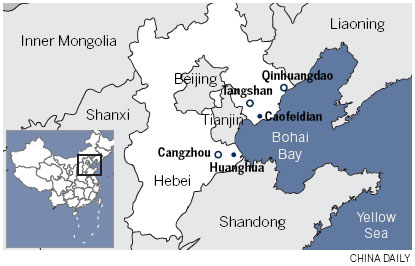![Infrastructure development is sparking an upturn in the economy at Caofeidian, an emerging industrial zone in Hebei province.[Photo/Xinhua] Infrastructure development is sparking an upturn in the economy at Caofeidian, an emerging industrial zone in Hebei province.[Photo/Xinhua]](U468P886T1D39909F12DT20121211110435.jpg)
Infrastructure development is sparking an upturn in the economy at Caofeidian, an emerging industrial zone in Hebei province.[Photo/Xinhua]

A vision from the past takes concrete shape to secure the future
'A great port will be built in northern China. It is my and my compatriots' idea to develop the port in a limited amount of time and make it as big as New York," says a line in Methods and Strategies of Establishing the Country, published in February 1919.
The author of those words was the revolutionary Sun Yat-sen (1866-1925), who wrote the Methods seven years after he declared the founding of the Republic of China and became its first president. At the time, China was divided by warlords and hard-pressed by poverty, but still Sun envisioned the port and detailed its location.
He wrote, "between Qinhuangdao and Dagukou", stands Caofeidian Port of Tangshan in North China's Hebei province. Originally an island of no more than 4 square kilometers, the port has expanded to cover an area of 210 sq km since marine reclamation work started in 2003.
More than 100 km south of Caofeidian, also on the coast of Bohai Bay, Huanghua Port, built in 1984, has emerged as China's second-largest coal exporting port. Its expansion has been rapid because Shenhua Group Co, China's biggest coal producer, has spent the past decade building its own port in Huanghua.
The two rapidly expanding ports are expected to be the drivers of an economic takeoff in Hebei, which encircles Beijing and Tianjin. The populous province provides the two municipalities with numerous resources and helps to shoulder their development costs.
The ports are also a demonstration of China's progress in the field of sustainable development. Projects, such as Shougang United Iron and Steel Co, which moved to Caofeidian from suburban Beijing ahead of the Beijing Olympics in 2008, have embraced the concept of the "circular economy" for the benefit of the environment.
Wang Zhongmin, general manager of Tangshan Caofeidian Shiye Port Co Ltd, has worked at the port for nine years. "I arrived when the infrastructure construction for the port began at the end of 2003. Soon, we were building a port for iron ore. It was urgently needed," he said.
At Caofeidian, five or six cargo vessels, each with the capacity to carry 200,000 metric tons of iron ore, are unloaded every day.
Analysts believe that the port's location means it has more advantages and greater potential than Qinhuangdao.
In 2011, construction was completed on the first and second phrases of iron ore ports, the first phrase of a coal port, crude oil and bulk terminals with a total turnover volume of 170 million tons, according to the Caofeidian local government.
The port will have a capacity of 300 million tons and turnover volume of 200 million tons by the end of the year, said Yang Jie, chief executive of Caofeidian district.
Yang said the port will eventually reach a total capacity of 500 million tons, becoming one of the largest ports in the world, when the projects are completed. Coal is the most important of the projects because of its impact on the energy supply in Southeast China.
On Nov 5, a coal port owned by SDIC Caofeidian Port Co, a subsidiary of the State Development and Investment Corp, was put into use. Construction work, including 10 coal berths and 18 store yards with total capacity of 8.37 million tons, started in 2006. The coal port alone has an annual capacity of 100 million tons.
The second phrase of Caofeidian coal port, which garnered investment of 5.4 billion yuan ($857 million), will be put into use in the first half of 2013 and a third coal port, with investment of 5.2 billion yuan, is still under construction, according to Yang.
"The planned coal capacity of Caofeidian will reach 350 million tons," she said.
There are a number of steel companies, including Hebei Iron and Steel Group Co and Shougang United Iron and Steel Co, in the province, and the coal and iron ore ports provide easy access to the fuel and raw materials they require, which helps to reduce costs.
"Importing iron ore at Caofeidian port has greatly helped nearby steel mills to reduce their logistics expenses," said Wang. "Plus, the port helps to deliver coal from the north, China's major coal producing area, to the southern provinces which are big consumers of electricity."
Both of China's major coal mining areas, Shanxi province and the Inner Mongolia autonomous region, neighbor Hebei. Coal and related products are transported to Qinhuangdao and Caofeidian ports and then distributed in the south of the country.
Qinhuangdao had a turnover of about 227 million tons of coal by mid-November, according to statistics from JYD Online Co Ltd, a bulk-commodity consultant in Beijing.
"The cost of transporting coal from the mining areas to Caofeidian is lower than to Qinhuangdao," said Dai Bing, director of the coal industry information department at JYD. "Caofeidian also has a greater number of highways than Qinhuangdao."
The Chinese government has encouraged the increased importation of fossil fuels, such as coal, and Caofeidian's location is more convenient for coal exporters overseas compared with Qinhuangdao port, he said.
Based on the port economy, the district will increase its efforts to establish trading centers for six major commodities, including coal, steel, iron ore and gas, which are intended to provide services for Chinese and foreign companies to start businesses in the region, according to the local government.
Meanwhile, next year will see construction start on an oil-refining project with an annual capacity of 10 million tons, a seawater desalination project with planned daily output of 1 million tons, and two power plants.

Copyright ©1999-2011 Chinanews.com. All rights reserved.
Reproduction in whole or in part without permission is prohibited.